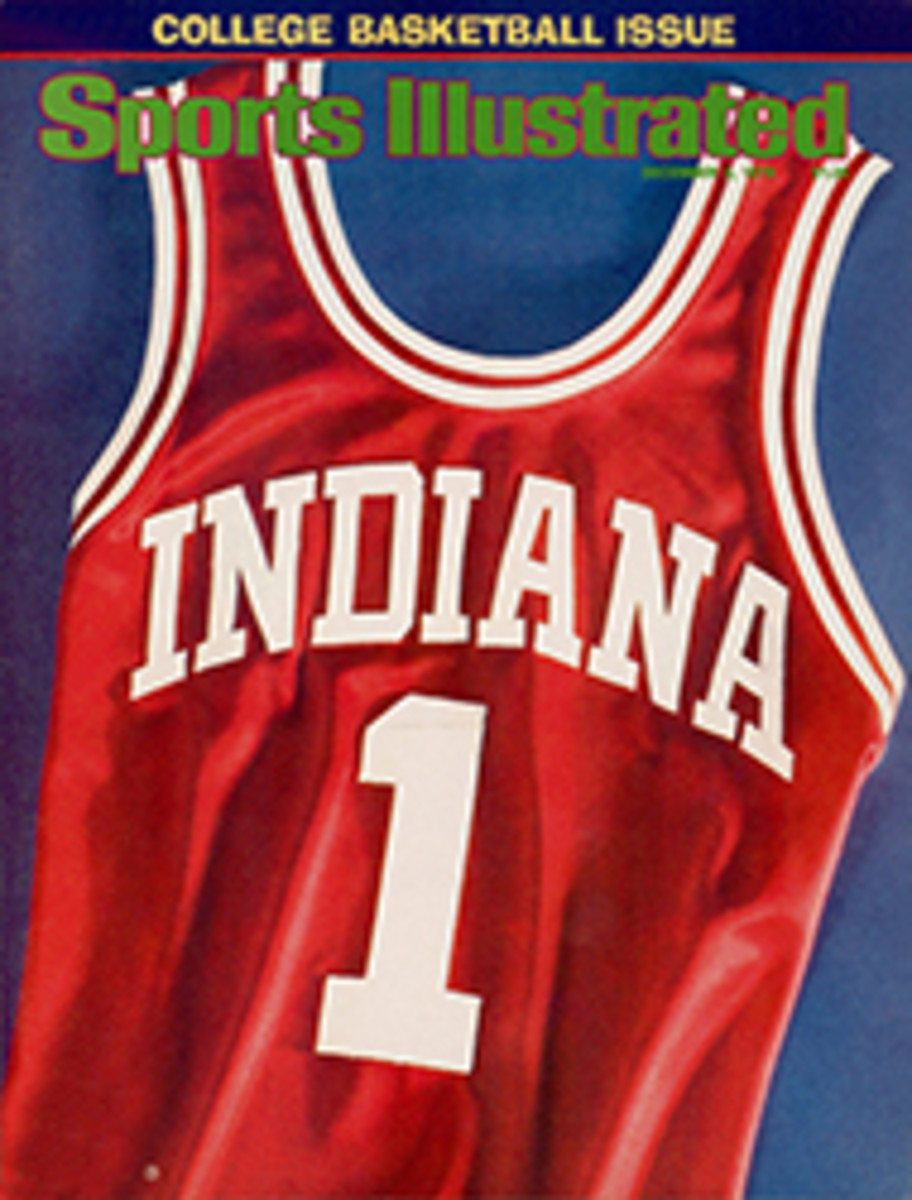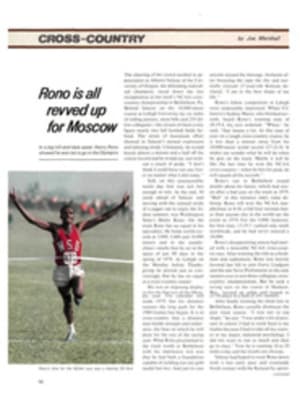
Rono is all revved up for Moscow
The cheering of the crowd swelled in appreciation as Alberto Salazar of the University of Oregon, the defending individual champion, raced down the last straightaway at last week's NCAA cross-country championship in Bethlehem, Pa. Behind Salazar on the 10,000-meter course at Lehigh University lay six miles of rolling pasture, steep hills and 235 fellow collegians—the closest of them a tiny figure nearly two full football fields behind. The strain of maximum effort showed in Salazar's pained expression and laboring stride. Ultimately, he would knock almost a minute and a half off the course record and he would say, not without a touch of pride, "I don't think I could have run any faster no matter what I did today."
Still, on this unseasonably warm day that was not fast enough to win. At the end, 50 yards ahead of Salazar and moving with the relaxed stride of a jogger out to enjoy the Indian summer, was Washington State's Henry Rono. On the track Rono has no equal in his specialties. He holds world records at 3,000, 5,000 and 10,000 meters and in the steeplechase—marks that he set in the space of just 80 days in the spring of 1978. At Lehigh on the Monday before Thanksgiving he proved just as convincingly that he has no equal as a cross-country runner.
His was an imposing display in this the first test of the Olympic year. The calendar still reads 1979, but for distance runners the long push for the 1980 Games has begun. It is in cross-country that a distance man builds strength and endurance, the base on which he will draw for the rest of the racing year. What Rono proclaimed to the track world in Bethlehem with his impressive win was that he had built a foundation capable of yielding not one gold medal but two. And just in case anyone missed the message, moments after breasting the tape the shy and normally reticent 27-year-old Kenyan declared, "I am in the best shape of my life."
Rono's fellow competitors at Lehigh were undeniably impressed. When Villanova's Sydney Maree, who finished seventh, heard Rono's winning time of 28:19.4, his eyes widened. "Whoo," he said, "that means a lot. At this time of year on a tough cross-country course, he is less than a minute away from his 10,000-meter world record [27:22.5]. It makes me wonder what he will do when he gets on the track. Maybe it will be like the last time he won the NCAA cross-country—when he hits his peak, he will squash all the records."
Rono's run in Bethlehem erased doubts about his future, which had arisen after a bad year on the track in 1979. "Bad" in this instance takes some defining. Rono still won the NCAA steeplechase in 8:18, a full four seconds faster than anyone else in the world ran the event in 1979. For the 5,000, however, his best time, 13:19.7, ranked only ninth worldwide, and he had never entered a 10,000.
Rono's disappointing season had started with a miserable NCAA cross-country race. After winning the title as a freshman and sophomore, Rono was heavily favored last fall to join Gerry Lindgren and the late Steve Prefontaine as the only runners ever to win three collegiate cross-country championships. But he took a wrong turn on the course at Madison, Wis., twisted an ankle, and jogged to 237th place in a field of 241 runners.
After finally winning the third title in Bethlehem, Rono casually dismissed the past track season. "I was not in top shape," he said. "I was under a lot of pressure in school. I had to work hard in my studies because I had to take all my courses in my major, industrial psychology. I did not want to run so much and then go to class." Now he is running 18 to 20 miles a day and the results are obvious.
Salazar had hoped to wear Rono down with a fast early pace and eventually break contact with the Kenyan by sprinting at one of the many blind spots on the course. But no matter how hard Salazar ran, Rono stuck with him, and with no apparent effort. At the five-mile mark, when he sensed that Salazar was straining, Rono moved effortlessly into the lead and ran away with the race. "I used to try to lead from the beginning," he said afterward. "Now I have so much confidence I just stay with the others and wait for the last mile to run."
Salazar suffered a double disappointment in Bethlehem when Oregon lost the team title, 86-93, to the University of Texas at El Paso. Oregon and UTEP had split the last six championships. This time Oregon was the first school to get five runners across the finish line, but UTEP, with four men among the top 20, secured the NCAA crown when its fifth man, freshman Tom Maweu, struggled home in 74th place.
For Salazar, who trained right through last summer despite a stress fracture in his left ankle, the fall cross-country season ended on a happy note. Last Saturday, just five days after the NCAA showdown, the AAU held its championship on a demanding, newly completed 10,000-meter course bordering North Carolina State's Carter-Finley Stadium in Raleigh. When Rono decided not to try to become the first to win an NCAA-AAU cross-country double, Salazar became the man to beat in the AAU. Once more he set a fast early pace. He was timed at the mile mark in a startling 4:08.3, a time he later refused to accept as accurate. At the top of a long hill between the one-and two-mile marks, Salazar broke away from the field and ran the rest of the way virtually alone. His time of 30:27.8 put him almost 20 seconds ahead of the second-place finisher, Herb Lindsay. What's more, Salazar's team, the Greater Boston Track Club, was also an easy winner, with four of the top five finishers.
This year, for the first time, the AAU held its men's and women's championships together, and the women stole the show at Raleigh. Perhaps it was because there was so much more at stake for the women: the first six finishers over the 5,000-meter loop—which the men ran twice—qualified for the national women's team, which will defend its title at the International Cross-Country Championship in March at Paris (the men's team will not be chosen until February). Moreover, there was the strong possibility that a woman would score the first collegiate-AAU double. And just to make matters more dramatic, the woman in question was Julie Shea of North Carolina State, a hometown girl from Raleigh.
Shea had won the Division I AIAW title the previous weekend in Tallahassee, covering the fast 5,000-meter course on Florida State's Seminole Golf Course in 16:35.0 and leading N.C. State to the team title in the process. Oregon was again second. Shea had won in Florida by outrunning Virginia's Margaret Groos up the last hill before the finish line. Then came her trademark—total collapse. Shea had to be pulled through the chute by officials, her feet dragging as if she were dead, her eyes half open with only the whites showing. That was the fourth time this year that Shea had beaten Groos, a fact that puzzled the third-place finisher, Lynn Jennings of Princeton. "Margaret is faster and stronger," said Jennings. "But Julie Shea is a very determined woman."
With that observation, Jennings went off to warm down with Groos, who is an old friend. Before they finished cooling off, they had agreed to run together at the AAU championship in the hope that both would win trips to Paris. So, in Raleigh it was Jennings who led through the first mile, with Jan Merrill, Groos and Shea grouped closely behind her. At the start of the long hill which Salazar later used to separate himself from the field, Jennings began to sprint. "Lynn looked back and shouted, 'Come on, Margaret,' " Groos related afterward. "I never would have gone at that pace without her. I usually try to stay behind Julie and catch her at the end. I probably would have done that again today, and it would have messed me up. I think I've just found a new way to race Julie."
At the two-mile mark, Jennings began to fade and Groos took the lead. Shea gave steady chase, but she was too far behind this time. "I kept thinking Margaret would come back to me," she said, "but she never did." Groos won in 16:53.9, almost eight seconds ahead of Shea. The third-place finisher, Merrill, was nearly 20 seconds back, and behind her was Brenda Webb of the Knoxville Track Club. Jennings staggered in fifth in 17:21.1, just half a second ahead of the last qualifier for the trip to Paris, Joan Benoit, the winner of the AIAW Division III title in Tallahassee and the No. 2-ranked female marathoner in the world.
When she had finished signing autographs and the press had left to watch the start of the men's race, Groos went looking for Jennings. The two finally spotted one another in the milling crowd of runners. The exhausted Jennings opened her arms wide for a big embrace and shouted, "Margaret, we made it. 'We'll always have Paris.' "
PHOTO
Rono's time for the NCAA race was a blazing 28:19.4.
PHOTO
Shea sagged after her AIAW win, then finished second at the AAUs.

